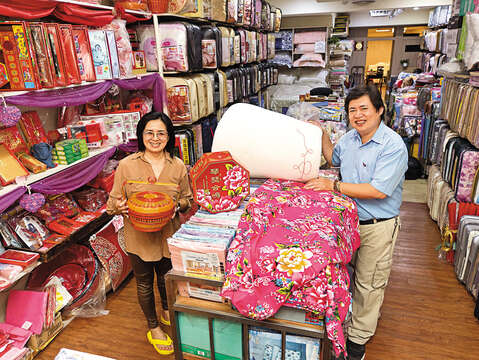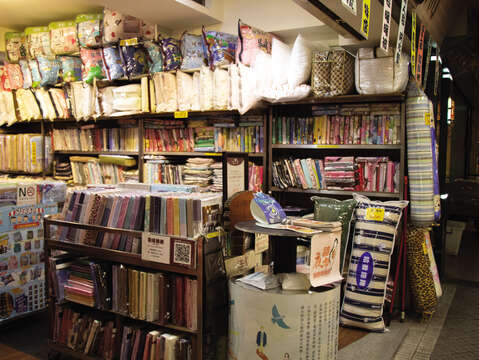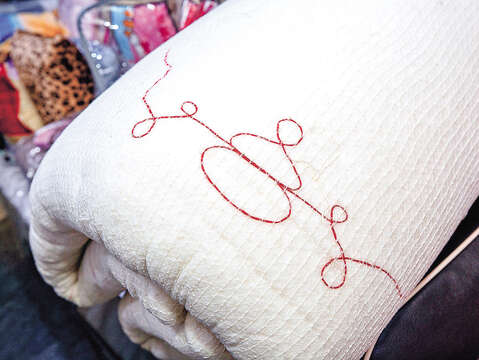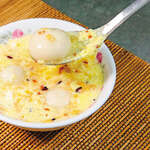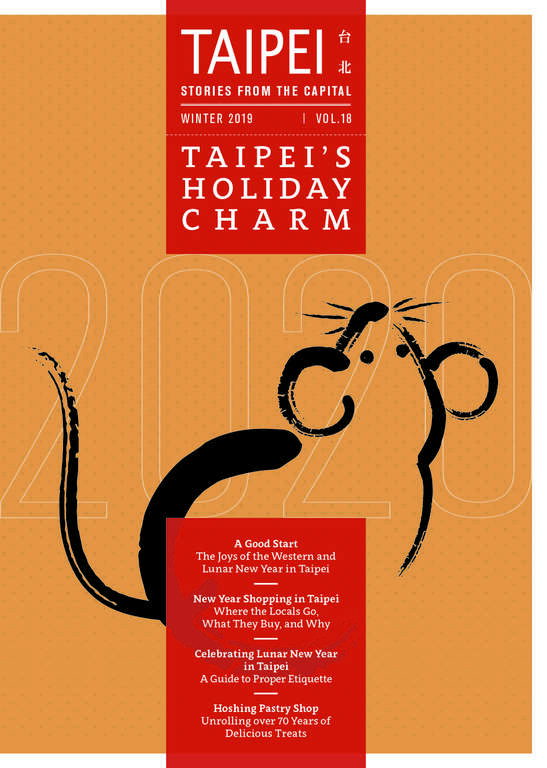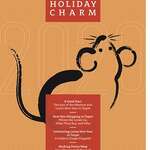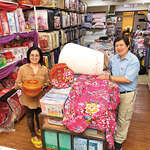Post date:2019-12-12
1157
TAIPEI #18 (2019 Winter)
Rui-Cheng Embroidered Red Calabash Passed down Through Five Generations of Warm Winter
PHOTOS BY Wang Hanshun, Marianne Krohn, MyTaiwanTour
TRANSLATION BY Joe Henley
In the early afternoon, only a few shops on Dadong Road (大東路) at Shilin Night Market (士林夜市) are open for business. However, you may already see customers entering Rui-Cheng Handmade Cotton Quilt Shop (瑞成手工棉被店), a 130-year-old shop hidden in the alley with a signboard that says “Dowry.”
HANDMADE COTTON QUILTS ENJOYED POPULARITY FOR A TIME
Zhang Baoren (張寶仁), the fifth-generation owner of this 130-year-old shop, has been working in the cotton quilt shop and factory since elementary school. With 40 years of experience, he serves as a long-term observer of the cotton quilt industry. Looking back on the history of his family business, he says that Rui-Cheng Handmade Cotton Quilt Shop was established 130 years ago in Dayuan Township in Taoyuan (桃園市大園鄉). In the old times, people purchased cotton quilts from quilt masters they were familiar with. Therefore, the handcrafted cotton quilts were distinguished by their red embroidered calabash trademark. Later, the family home in Dayuan was destroyed by a fire, so the third-generation owner, Li Huolin (李火琳), decided to start over in Taipei. Li was a grounded and cunning businessman. When it comes to cotton quilts, the older generations in the Shilin and Yangmingshan areas would immediately think of the calabash trademark and its owner “Uncle Huolin.”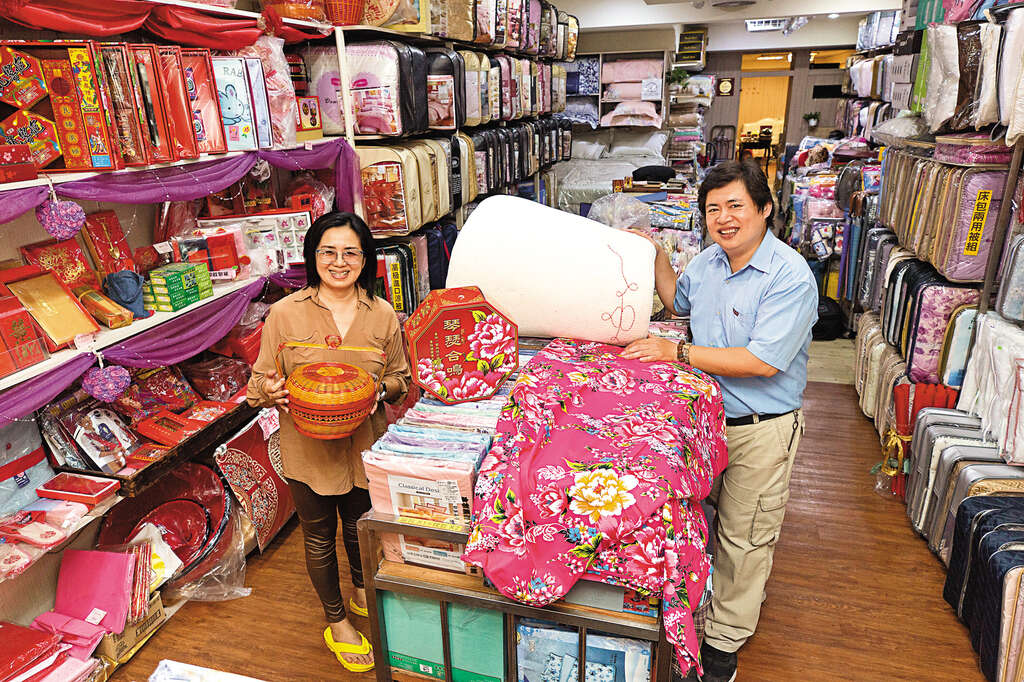 ▲Zhang Baoren and his wife runs their century-old cotton quilt shop. Its good reputation online has brought great success. (Photo / Wang Hanshun)
▲Zhang Baoren and his wife runs their century-old cotton quilt shop. Its good reputation online has brought great success. (Photo / Wang Hanshun)
Zhang mentions the time when the older generations made cotton quilts by hand. Since humidity may deteriorate the quality of the natural cotton used in quilts, all the hand-picked cotton of the day must be quilted to prevent it from producing dew after contact with air, so the quilt masters usually worked long hours every day. Operating the cotton fluffing instrument was very energy consuming, and winter quilts were usually made during the hot months of summer and autumn. The cotton fibers flying in the air was harmful for the respiratory system. Therefore, the handmade cotton quilt was the fruit of the excellent skills and immense effort of the quilt masters. Because the raw material was pure cotton fiber, cotton quilts would not harden easily, and were considered exceptionally warm and comfortable.
According to Zhang, during Taiwan’s agrarian period, life was plain and simple, and quilts were a high value commodity that could be pawned. Afterwards when the economy took off during the industrial period, the sales for quilts surged higher because adults and children had their own demand for quilts. Zhang recalls the golden years when his parents were running the quilt shop. It was during the 1970s when Taiwan’s economy was gradually taking off, and buying new cotton quilts as a wedding dowry was still the tradition. Rui-Cheng became a synonym for selling orthodox handmade quilts, and the sales reached their peak in 1977. Zhang shares his mother’s words about the prosperity of the industry in the past. Around 30 cotton quilts were handcrafted by 10 quilt masters every day. The price of a 6-kilogram cotton quilt was NT$800, or the equivalent of half a month’s average salary at that time.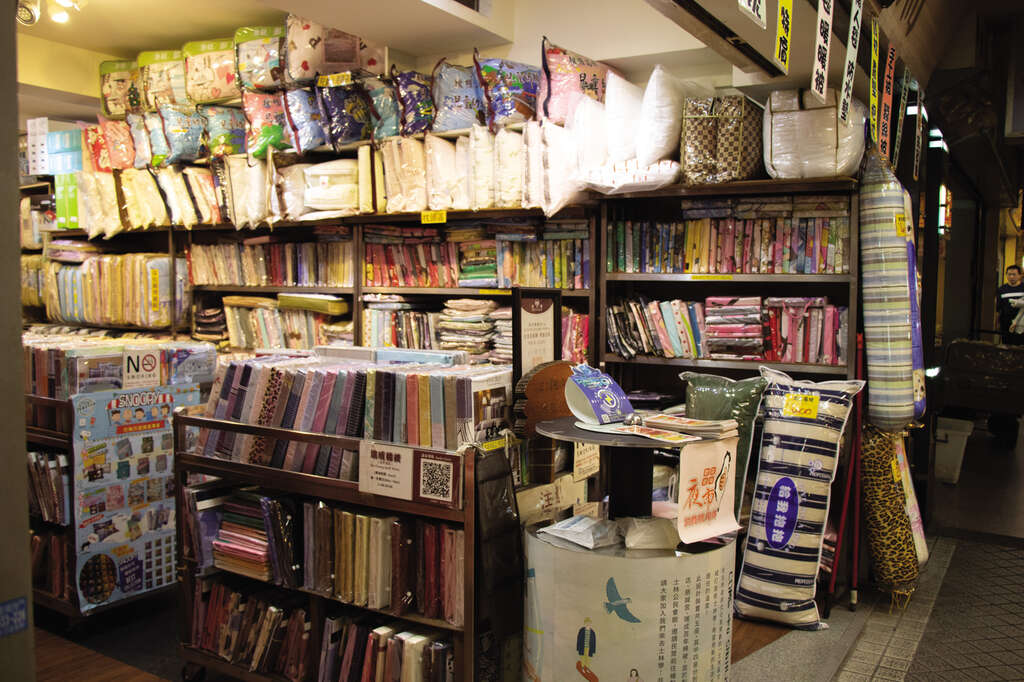 ▲Rui-Cheng is now selling all kinds of trendy duvets and wool quilts, giving customers multiple choices to purchase. (Photo / MyTaiwanTour)
▲Rui-Cheng is now selling all kinds of trendy duvets and wool quilts, giving customers multiple choices to purchase. (Photo / MyTaiwanTour)
HOW THE INTERNET HAS REVIVED THE OLD BRAND
However, the prosperity of the traditional industry proved difficult to continue. More than 20 years ago, Zhang took over the shop and faced the challenge of transformation. In 1987, Rui-Cheng changed their business model from making and selling quilts by themselves to selling less expensive chemical fiber quilts to meet the needs of students. Meanwhile, they expanded their product offerings, selling trendy duvets and wool quilts, along with a new bargain basement low-price strategy commonly used in night markets to gradually bring the business back to life.
“Nowadays, sales of handmade cotton quilts account for only one tenth of the revenue, while latecomer items of bedding and home furnishings have gradually become the main sales drivers,” says Zhang. He doesn’t deny that many businesses have encountered major changes since Taiwan joined World Trade Organization in 2002. Afterwards, the rise of smartphones allowed people to compare prices and shop online, which caused major sales declines for traditional brick-and-mortar shops. Fortunately, Zhang went with the tailwind of the online shopping revolution by launching the centuryold business’s website as another marketing channel.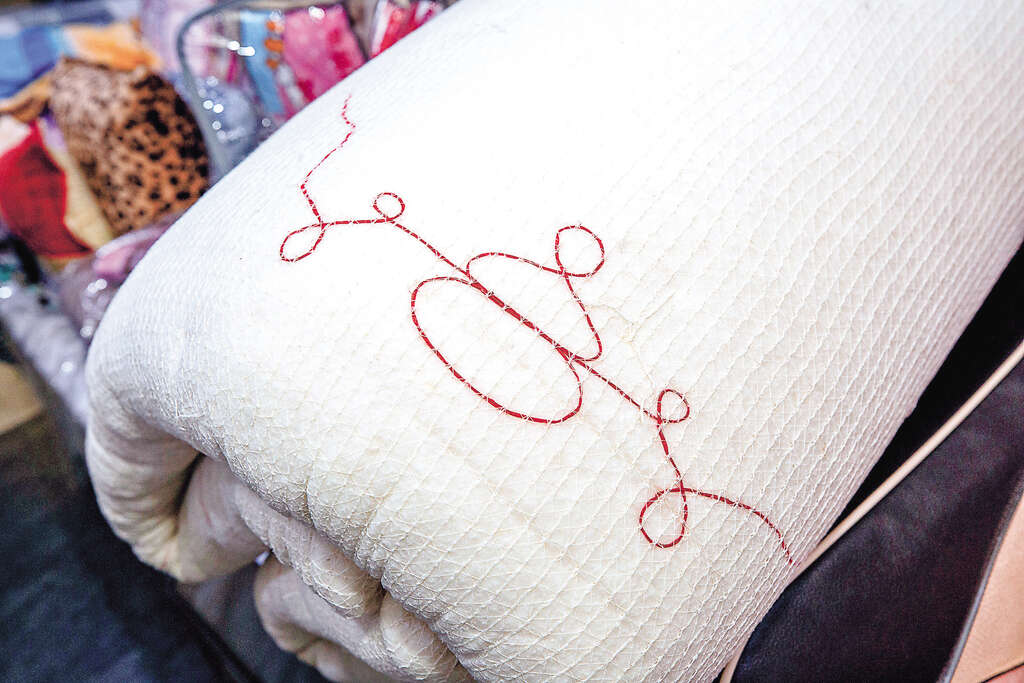 ▲Calabash embroidered with red thread has been the classic trademark of RuiCheng for five generations. (Photo / Wang Hanshun)
▲Calabash embroidered with red thread has been the classic trademark of RuiCheng for five generations. (Photo / Wang Hanshun)
“In addition to the existing official website and fan page, I would proactively reply to consumers’ questions online to increase our publicity,” he says. He also admits frankly that people nowadays are worried about the quality of the products online, so they will first review the shop’s reputation online before calling for more information. Currently, online orders from search results account for 50% of Rui-Cheng’s sales volume.
The once expensive handmade cotton quilts have become a necessity available to all. Facing stiff competition, Rui-Cheng, the century-old shop, gets people in Taipei through every chilly winter with its pure and down to earth nature.
Rui-Cheng Embroidered Red Calabash Passed down Through Five Generations of Warm Winter
WORDS BY Chen Wanyu
PHOTOS BY Wang Hanshun, Marianne Krohn, MyTaiwanTour
TRANSLATION BY Joe Henley
In the early afternoon, only a few shops on Dadong Road (大東路) at Shilin Night Market (士林夜市) are open for business. However, you may already see customers entering Rui-Cheng Handmade Cotton Quilt Shop (瑞成手工棉被店), a 130-year-old shop hidden in the alley with a signboard that says “Dowry.”
HANDMADE COTTON QUILTS ENJOYED POPULARITY FOR A TIME
Zhang Baoren (張寶仁), the fifth-generation owner of this 130-year-old shop, has been working in the cotton quilt shop and factory since elementary school. With 40 years of experience, he serves as a long-term observer of the cotton quilt industry. Looking back on the history of his family business, he says that Rui-Cheng Handmade Cotton Quilt Shop was established 130 years ago in Dayuan Township in Taoyuan (桃園市大園鄉). In the old times, people purchased cotton quilts from quilt masters they were familiar with. Therefore, the handcrafted cotton quilts were distinguished by their red embroidered calabash trademark. Later, the family home in Dayuan was destroyed by a fire, so the third-generation owner, Li Huolin (李火琳), decided to start over in Taipei. Li was a grounded and cunning businessman. When it comes to cotton quilts, the older generations in the Shilin and Yangmingshan areas would immediately think of the calabash trademark and its owner “Uncle Huolin.”
 ▲Zhang Baoren and his wife runs their century-old cotton quilt shop. Its good reputation online has brought great success. (Photo / Wang Hanshun)
▲Zhang Baoren and his wife runs their century-old cotton quilt shop. Its good reputation online has brought great success. (Photo / Wang Hanshun)Zhang mentions the time when the older generations made cotton quilts by hand. Since humidity may deteriorate the quality of the natural cotton used in quilts, all the hand-picked cotton of the day must be quilted to prevent it from producing dew after contact with air, so the quilt masters usually worked long hours every day. Operating the cotton fluffing instrument was very energy consuming, and winter quilts were usually made during the hot months of summer and autumn. The cotton fibers flying in the air was harmful for the respiratory system. Therefore, the handmade cotton quilt was the fruit of the excellent skills and immense effort of the quilt masters. Because the raw material was pure cotton fiber, cotton quilts would not harden easily, and were considered exceptionally warm and comfortable.
According to Zhang, during Taiwan’s agrarian period, life was plain and simple, and quilts were a high value commodity that could be pawned. Afterwards when the economy took off during the industrial period, the sales for quilts surged higher because adults and children had their own demand for quilts. Zhang recalls the golden years when his parents were running the quilt shop. It was during the 1970s when Taiwan’s economy was gradually taking off, and buying new cotton quilts as a wedding dowry was still the tradition. Rui-Cheng became a synonym for selling orthodox handmade quilts, and the sales reached their peak in 1977. Zhang shares his mother’s words about the prosperity of the industry in the past. Around 30 cotton quilts were handcrafted by 10 quilt masters every day. The price of a 6-kilogram cotton quilt was NT$800, or the equivalent of half a month’s average salary at that time.
 ▲Rui-Cheng is now selling all kinds of trendy duvets and wool quilts, giving customers multiple choices to purchase. (Photo / MyTaiwanTour)
▲Rui-Cheng is now selling all kinds of trendy duvets and wool quilts, giving customers multiple choices to purchase. (Photo / MyTaiwanTour) HOW THE INTERNET HAS REVIVED THE OLD BRAND
However, the prosperity of the traditional industry proved difficult to continue. More than 20 years ago, Zhang took over the shop and faced the challenge of transformation. In 1987, Rui-Cheng changed their business model from making and selling quilts by themselves to selling less expensive chemical fiber quilts to meet the needs of students. Meanwhile, they expanded their product offerings, selling trendy duvets and wool quilts, along with a new bargain basement low-price strategy commonly used in night markets to gradually bring the business back to life.
“Nowadays, sales of handmade cotton quilts account for only one tenth of the revenue, while latecomer items of bedding and home furnishings have gradually become the main sales drivers,” says Zhang. He doesn’t deny that many businesses have encountered major changes since Taiwan joined World Trade Organization in 2002. Afterwards, the rise of smartphones allowed people to compare prices and shop online, which caused major sales declines for traditional brick-and-mortar shops. Fortunately, Zhang went with the tailwind of the online shopping revolution by launching the centuryold business’s website as another marketing channel.
 ▲Calabash embroidered with red thread has been the classic trademark of RuiCheng for five generations. (Photo / Wang Hanshun)
▲Calabash embroidered with red thread has been the classic trademark of RuiCheng for five generations. (Photo / Wang Hanshun)“In addition to the existing official website and fan page, I would proactively reply to consumers’ questions online to increase our publicity,” he says. He also admits frankly that people nowadays are worried about the quality of the products online, so they will first review the shop’s reputation online before calling for more information. Currently, online orders from search results account for 50% of Rui-Cheng’s sales volume.
The once expensive handmade cotton quilts have become a necessity available to all. Facing stiff competition, Rui-Cheng, the century-old shop, gets people in Taipei through every chilly winter with its pure and down to earth nature.
Gallery
:::
Popular articles
 TAIPEI Quarterly 2019 Winter Vol.18
TAIPEI Quarterly 2019 Winter Vol.18 Celebrating Lunar New Year in Taipei: A Guide to Proper Etiquette (TAIPEI Quarterly 2019 Winter Vol.18)
Celebrating Lunar New Year in Taipei: A Guide to Proper Etiquette (TAIPEI Quarterly 2019 Winter Vol.18) Everything Is Illuminated — Taipei During the Lantern Festival (TAIPEI Quarterly 2019 Winter Vol.18)
Everything Is Illuminated — Taipei During the Lantern Festival (TAIPEI Quarterly 2019 Winter Vol.18) Rui-Cheng Embroidered Red Calabash Passed down Through Five Generations of Warm Winter (TAIPEI Quarterly 2019 Winter Vol.18)
Rui-Cheng Embroidered Red Calabash Passed down Through Five Generations of Warm Winter (TAIPEI Quarterly 2019 Winter Vol.18) Handmade Tangyuan — Every One a Treasure unto Its Own (TAIPEI Quarterly 2019 Winter Vol.18)
Handmade Tangyuan — Every One a Treasure unto Its Own (TAIPEI Quarterly 2019 Winter Vol.18) Warming, Hearty, Comforting Year-End Hot Pot Gatherings (TAIPEI Quarterly 2019 Winter Vol.18)
Warming, Hearty, Comforting Year-End Hot Pot Gatherings (TAIPEI Quarterly 2019 Winter Vol.18)
 Rui-Cheng Embroidered Red Calabash Passed down Through Five Generations of Warm Winter (TAIPEI Quarterly 2019 Winter Vol.18)
Rui-Cheng Embroidered Red Calabash Passed down Through Five Generations of Warm Winter (TAIPEI Quarterly 2019 Winter Vol.18)